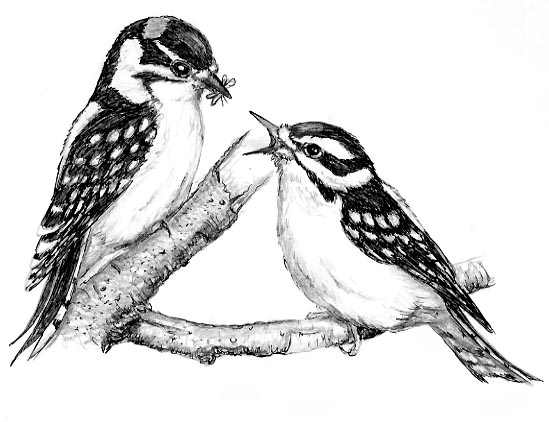
Dear Bird Folks,
Back in July my wife and I observed a Downy Woodpecker feeding another Downy Woodpecker, like it was feeding a chick, but both birds were adults. We assumed that this was some kind of mating ritual. Then a few weeks later, in August, we saw a pair of adult Rufous-sided Towhees feeding each other. My wife thinks that it’s a little late for mating behavior, but why were these birds feeding each other?
– Charles, Brewster, MA
Sorry Charlie,
I’m sorry that your question looks a bit different than the one you sent us. As you can tell we had to do some big-time editing. It’s not that your question was bad or had anything inappropriate for family viewing. Actually, it was very entertaining and fun to read, but the problem was that it was waaay tooo looong. It was just a few lines shorter than “War and Peace.” If I had used your entire question, there would not have been enough room left to print the paper’s weekly wind farm story. What would people do without that?
Mate-feeding is indeed a mating ritual for some nesting birds. The male offering the female food before breeding has been observed in many species including grebes, siskins, cardinals, and of course, humans. However, I don’t know that it’s an important part of pair bonding with Downy Woodpeckers. When it comes to two Downys hooking up, it’s not the food that counts the most, it’s the wood.
The life of a Downy Woodpecker revolves around trees, whether the trees be dead, alive or somewhere in between. They use trees to live in, as their food source and to attract a mate. In the spring both the male and the female use drumming to get each others attention. They drum on the nearest tree, hollow branch, or when they are in a fun-loving mood, the cedar siding of your neighbor’s house.
An important part of the two birds’ courtship is the selection of the nesting tree. Several trees may be inspected but ultimately the woodpeckers must agree on the same tree. If they can’t agree where they both will live then the engagement is off. They don’t argue, the two birds simply smile and go their separate ways. There are no lawyers, threatening letters or restraining orders. But if both birds happen to like the same tree, then the party’s on.
Since this woodpecker’s pair bonding revolves around tree selection and not mate-feeding, I doubt if the woodpeckers that you saw were adults looking to breed. The bird you saw feeding another was more than likely a parent bird feeding one of its young. Although they are not identical, young downys look very much like their parents and it would be easy to confuse the two, especially for someone from Brewster.
Now we move on to the Rufous-sided Towhee portion of your question. The first thing I need to tell you, Charlie, is that you should get yourself a new bird book. The bird gurus stopped using the name “rufous-sided” years ago. The bird is now called “Eastern Towhee.” We could get into the reason why the name was changed, but that would take too long and when you think about it, who cares?
The towhees’ world is much different than the woodpeckers. They spend most of their life scratching out a living in the dirt, literally. Towhees live on the ground, feed on the ground and nest very close to the ground. When the females arrive in the spring, the males do the usual bird attraction stuff. You know, singing, flashing their tail feathers and zipping around crazy trying to get themselves noticed by the babes. A male may even pick up a piece of nesting material to show to the female, but I’ve never read that he will offer her any food. So once again, Charlie, I’m going to have to squash your theory that one towhee feeding another is a type of courting behavior.
Unlike baby Downy Woodpeckers, for the first month or so young towhees look a lot different than their parents. You would clearly know if an adult bird was feeding its a mate or if it was feeding one of its offspring. However (and you knew this was coming), by mid to late August the new birds have molted out of their juvenile plumage into a plumage that makes them look more like the adult birds. Thus, and once again, you may have been seeing adults feeding their kids.
You are correct in thinking that mate-feeding is part of some bird’s courtship, Charlie, but I don’t think it is an important behavior for either the Downy Woodpecker or the Eastern Towhee. I have the feeling that what you thought were mates feeding each other were probably just parents feeding their own young.
As far as your wife thinking that “it’s a little late for mating behavior,” I can’t help you with that. You are going to have to work that out with her.